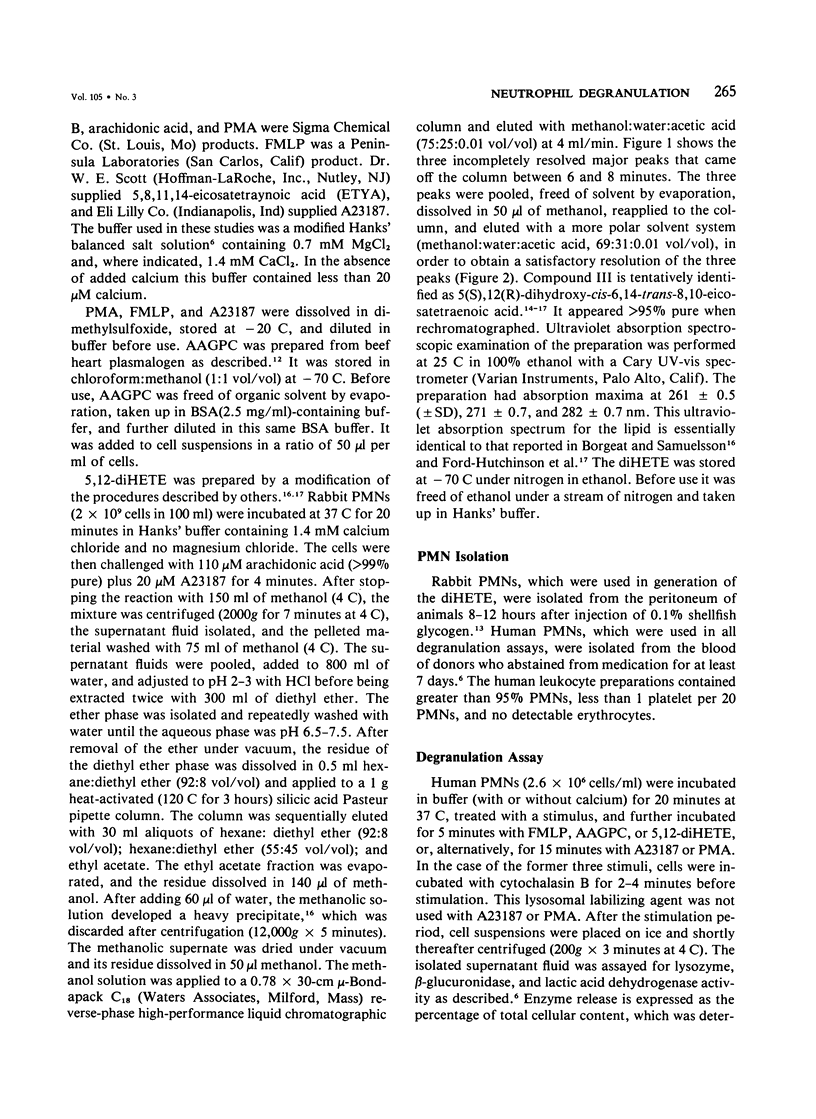Abstract
5,12-Dihydroxy-6,8,10,14-eicosatetraenoic acid was prepared from rabbit neutrophils challenged with ionophore A23187 plus arachidonic acid. It was purified by reverse-phase high-performance liquid chromatography with the use of a two-step procedure that effectively resolved the lipid from closely eluting contaminants. The phospholipid 1-O-alkyl-2-O-acetyl-sn-glycero-3-phosphocholine was prepared from beef heart plasmalogen. Confirming earlier reports, both lipids stimulated human polymorphonuclear neutrophils to release granule-bound enzymes. Their respective degranulating actions took less than 5 minutes to become maximal, were dependent upon the presence of cytochalasin B, and required intact pathways of arachidonic acid metabolism, as judged by the inhibitory actions of arachidonate antimetabolites. Neither lipid required more than trace concentrations of extracellular calcium to effect optimal amounts of enzyme release. In one or more of these regards the two lipids differed strikingly from other neutrophil-degranulating agents such as A23187, N-formyl-methionyl-leucyl-phenylalanine, and phorbol myristate acetate. The mechanism of action of the two lipid stimuli, therefore, appear to differ somewhat from the mechanisms of the other three stimuli.
Full text
PDF





Selected References
These references are in PubMed. This may not be the complete list of references from this article.
- Bentwood B. J., Henson P. M. The sequential release of granule constitutents from human neutrophils. J Immunol. 1980 Feb;124(2):855–862. [PubMed] [Google Scholar]
- Bokoch G. M., Reed P. W. Effect of various lipoxygenase metabolites of arachidonic acid on degranulation of polymorphonuclear leukocytes. J Biol Chem. 1981 Jun 10;256(11):5317–5320. [PubMed] [Google Scholar]
- Bokoch G. M., Reed P. W. Stimulation of arachidonic acid metabolism in the polymorphonuclear leukocyte by an N-formylated peptide. Comparison with ionophore A23187. J Biol Chem. 1980 Nov 10;255(21):10223–10226. [PubMed] [Google Scholar]
- Borgeat P., Samuelsson B. Arachidonic acid metabolism in polymorphonuclear leukocytes: effects of ionophore A23187. Proc Natl Acad Sci U S A. 1979 May;76(5):2148–2152. doi: 10.1073/pnas.76.5.2148. [DOI] [PMC free article] [PubMed] [Google Scholar]
- Ford-Hutchinson A. W., Bray M. A., Cunningham F. M., Davidson E. M., Smith M. J. Isomers of leukotriene B4 possess different biological potencies. Prostaglandins. 1981 Jan;21(1):143–152. doi: 10.1016/0090-6980(81)90204-5. [DOI] [PubMed] [Google Scholar]
- Goetzl E. J., Derian C. K., Tauber A. I., Valone F. H. Novel effects of 1-O-hexadecyl-2-acyl-sn-glycero-3-phosphorycholine mediators on human leukocyte function: delineation of the specific roles of the acyl substituents. Biochem Biophys Res Commun. 1980 Jun 16;94(3):881–888. doi: 10.1016/0006-291x(80)91317-0. [DOI] [PubMed] [Google Scholar]
- Goetzl E. J., Pickett W. C. The human PMN leukocyte chemotactic activity of complex hydroxy-eicosatetraenoic acids (HETEs). J Immunol. 1980 Oct;125(4):1789–1791. [PubMed] [Google Scholar]
- Goldstein I. M., Horn J. K., Kaplan H. B., Weissmann G. Calcium-induced lysozyme secretion from human polymorphonuclear leukocytes. Biochem Biophys Res Commun. 1974 Sep 23;60(2):807–812. doi: 10.1016/0006-291x(74)90312-x. [DOI] [PubMed] [Google Scholar]
- Naccache P. H., Showell H. J., Becker E. L., Sha'afi R. I. Changes in ionic movements across rabbit polymorphonuclear leukocyte membranes during lysosomal enzyme release. Possible ionic basis for lysosomal enzyme release. J Cell Biol. 1977 Dec;75(3):635–649. doi: 10.1083/jcb.75.3.635. [DOI] [PMC free article] [PubMed] [Google Scholar]
- Naccache P. H., Showell H. J., Becker E. L., Sha'afi R. I. Transport of sodium, potassium, and calcium across rabbit polymorphonuclear leukocyte membranes. Effect of chemotactic factor. J Cell Biol. 1977 May;73(2):428–444. doi: 10.1083/jcb.73.2.428. [DOI] [PMC free article] [PubMed] [Google Scholar]
- O'Flaherty J. T., Dechatelet L. R., McCall C. E., Bass D. A. Neutrophil aggregation: evidence for a different mechanism of action by phorbol myristate acetate. Proc Soc Exp Biol Med. 1980 Nov;165(2):225–232. doi: 10.3181/00379727-165-40962. [DOI] [PubMed] [Google Scholar]
- O'Flaherty J. T., Showell H. J., Ward P. A., Becker E. L. A possible role of arachidonic acid in human neutrophil aggregation and degranulation. Am J Pathol. 1979 Sep;96(3):799–810. [PMC free article] [PubMed] [Google Scholar]
- O'Flaherty J. T., Wykle R. L., Miller C. H., Lewis J. C., Waite M., Bass D. A., McCall C. E., DeChatelet L. R. 1-O-Alkyl-sn-glyceryl-3-phosphorylcholines: a novel class of neutrophil stimulants. Am J Pathol. 1981 Apr;103(1):70–78. [PMC free article] [PubMed] [Google Scholar]
- Roos D., Bot A. A., van Schaik M. L., de Boer M., Daha M. R. Interaction between human neutrophils and zymosan particles: the role of opsonins and divalent cations. J Immunol. 1981 Feb;126(2):433–440. [PubMed] [Google Scholar]
- Rubin R. P., Sink L. E., Schrey M. P., Day A. R., Liao C. S., Freer R. J. Secretagogues for lysosomal enzyme release as stimulants of arachidonyl phosphatidylinositol turnover in rabbit neutrophils. Biochem Biophys Res Commun. 1979 Oct 29;90(4):1364–1370. doi: 10.1016/0006-291x(79)91186-0. [DOI] [PubMed] [Google Scholar]
- Showell H. J., Naccache P. H., Sha'afi R. I., Becker E. L. Inhibition of rabbit neutrophil lysosomal enzyme secretion, non-stimulated and chemotactic factor stimulated locomotion by nordihydroguaiaretic acid. Life Sci. 1980 Aug 4;27(5):421–426. doi: 10.1016/0024-3205(80)90191-5. [DOI] [PubMed] [Google Scholar]
- Showell H. J., Naccache P. H., Sha'afi R. I., Becker E. L. The effects of extracellular K+, Na+ and Ca++ on lysosomal enzyme secretion from polymorphonuclear leukocytes. J Immunol. 1977 Sep;119(3):804–811. [PubMed] [Google Scholar]
- Smolen J. E., Weissmann G. Effects of indomethacin, 5,8,11,14-eicosatetraynoic acid, and p-bromophenacyl bromide on lysosomal enzyme release and superoxide anion generation by human polymorphonuclear leukocytes. Biochem Pharmacol. 1980 Feb 15;29(4):533–538. doi: 10.1016/0006-2952(80)90373-1. [DOI] [PubMed] [Google Scholar]
- Volpi M., Naccache P. H., Sha'afi R. I. Arachidonate metabolite(s) increase the permeability of the plasma membrane of the neutrophils to calcium. Biochem Biophys Res Commun. 1980 Feb 27;92(4):1231–1237. doi: 10.1016/0006-291x(80)90418-0. [DOI] [PubMed] [Google Scholar]
- Yurewicz E. C., Zimmerman M. Cytochalasin B-dependent release of azurophil granule enzymes from human polymorphonuclear leukocytes. Inflammation. 1977 Dec;2(4):259–264. doi: 10.1007/BF00921005. [DOI] [PubMed] [Google Scholar]


